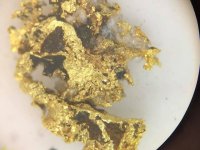RTD-Tech
Jr. Member
Hello all,
I built myself a miller table.
When I was testing it last weekend I did find a few pieces of fine gold in my concentrates, but nothing that I would think of as flour gold. Also I'm not sure if there was any flour gold in my material or if I just didn't set it up and operate it correctly.
If anyone has any suggestions, they would be greatly appreciated.
The surface is painted with black chalkboard paint. It's size is about 12x24 inches.
I built myself a miller table.
When I was testing it last weekend I did find a few pieces of fine gold in my concentrates, but nothing that I would think of as flour gold. Also I'm not sure if there was any flour gold in my material or if I just didn't set it up and operate it correctly.
If anyone has any suggestions, they would be greatly appreciated.
The surface is painted with black chalkboard paint. It's size is about 12x24 inches.
Upvote
0









